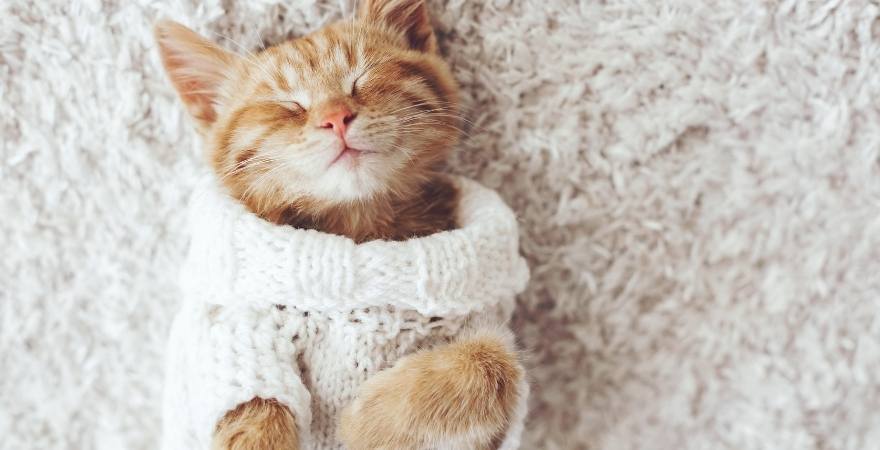You adore kitty, their hairballs? not so much...
Sigh, hairballs.
While you’re busy cleaning up that mess in your mind, or in real life, hairballs are a natural part of any cat’s grooming process. Cats are clean freaks by nature, and they spend at least five hours a day grooming themselves. What exactly are they getting rid of? Loose hair, which kitty has a lot of.

Photo by John Pemble via Flickr.
The (hairy) matter at hand
Ever wonder why kitty’s tongue is so rough when they give you a (rare) kiss?
Turns out small, backward slanted projections (aka papillae) help push indigestible hair down the throat into their stomach.
Most of the hair does pass through the digestive tract and comes out as poop, but the hair left behind starts forming a clump and becomes a hairball. We don’t have to get into gory details about how your cat sounds when they’re getting rid of a hairball (if you’re new to pet parenting and reading this... you’ll find out soon enough), but instead of spherical shape you see in cartoons, it’s more likely to have a tube-shape — since the hair is coming out the esophagus.
Long hair cats groom themselves more often — and swallow more hair — which does mean more cleanup duty for pet parents to maine coon or persian kitties. Also, expect to see (and hear) more fur balls come up around Spring/Summer, when kitty is shedding their thicker coat from the winter.
How comes you’re dealing with this now as opposed to when kitty was a kitten? Well, kittens happen to have less hair and less practice grooming properly, sort of like when you were learning to shower by yourself, you definitely had to go back a second time.

Photo by panli54 via Flickr
No hairball? There might be a problem...
Un-fun as hairballs are, they’re totally normal and harmless - expect the unwelcome guest to come up about once a week or two. However, if you start seeing kitty become lethargic, refusing to eat, and not seeing anything come after multiple attempts of getting a hairball up, something more serious is going on. If the hairball isn’t coming out from either side, it might be stuck in kitty’s intestine and could cause life-threatening problems in their digestive tract.
Depending on the seriousness of the situation, surgery may be the only way to get that wad of fur out.
So, how do you make sure that kitty can keep up their good habit — and you keep your sanity?

Photo by Tambako The Jaguar via Flickr
Getting kitty accustomed to some extra help from you in the grooming department is a great start, regular brushing reduces the size of the furballs (remember, you’re never not going to have hairballs) in the future.
If they prefer to take care of their coats solo, a slight change in their diet, the kind made with ingredients that slows down shedding and keeps coats shiny, just might be what keeps you from stepping in wet, furry mishaps.
We have just the thing.
yummy perks
Scruffy Paws Hairball be Gone Support Chews are made with ingredients known for keeping skin and hair healthy (hint: it’s probably one of the ingredients in your multivitamin chew), as well as taking care of the digestive and urinary systems. Not sure if kitty will take to the new addition at meal time? These chews come in a kitty-tested chicken liver flavor — not bad for something that’s good for kitty right?!
the science
Omega 3 and 6 Fatty Acids: A powerhouse duo with a reputation for maintaining heart and mental health in people, a regular dose of these two also happen to improve skin and coat health in cats — nothing like a healthy, shiny coat kitty!
Psyllium Husk: Gentle and effective, psyllium absorbs water and turns into a gooey blob that doesn’t actually get digested. This is good because psyllium works as a natural laxative that takes all the bad stuff out of your body. Also, the study we worked with found that a regular diet of psyllium reduced the amount of hairballs cats produced over a two week period, during shedding season. Long hair cat parents rejoice!
Zinc: Like the Omegas above, Zinc also has a reputation of improving coat health in cats, and a deficiency leads to skin lesions and shedding. Biotin: Already known for improving skin, hair and nails in humans, Biotin also has the same effect for cats, and the less biotin means your cat is more likely to suffer from scaly skin.
One last thing
Just so you know, you can always read the studies for yourself in the Scientific Backing section of our products page, and our products are always made right here in the United States.
It’s not all purrs and snuggles for you and kitty — if anything those are earned through cleaning up the yucky stuff, hairballs included.

Photo by Phuket@photographer.net via Flickr

Stephanie Pollard
Writer. Pet Enthusiast. Ambivert.



